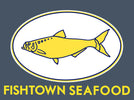Wild Salmon: A Sidebar in Bear Deluxe Magazine 2011
Ten million years of evolution and migration patterns (when salmon swim from salt water up river to spawn) created genetically unique species of wild salmon in every river system. In 1894 our notion of wild salmon began to change when the first salmon hatchery on the Columbia River was built. Hatcheries now release five billion salmon into the Pacific Ocean every year and these salmon are considered 'wild' as defined by distributors and consumers alike.
Currently, at the grocery store there are only 2 types of salmon to choose from: farm-raised and wild. Unbeknownst to the average consumer, 'wild' salmon includes native salmon (naturally born in rivers) and hatchery produced salmon (born in captivity).
The Seattle-based Purse Seine Vessel Owners Association (PSVOA) will pay Washington Division of Fish and Wildlife (WDFW) $157,825 per year to operate a salmon hatchery. These hatchery salmon will be commercially fished and sold as 'wild salmon'. Hatchery salmon mask the fact that as of today over 400 genetically unique species of salmon (nearly 30%) are now extinct.
The reality is there are three categories salmon: native, farm-raised, and hatchery. Native fish are born in rivers, truly wild, and genetic descendants of the salmon that spawned in the same river ten million years ago. Farm-raised salmon are born in captivity. Then they are placed into pens in the ocean until large enough to harvest. Hatchery salmon are also born in captivity and released into rivers as smolts (juvenile salmon). When this hatchery salmon is caught in the ocean and sold at market, it is billed as a 'wild salmon'. In the Pacific Northwest over 80 percent of 'wild salmon' are products of hatcheries. In Alaska over 31 percent of 'wild salmon' are hatchery produced.
There is one place in the Pacific Northwest where a genetically native species of salmon exist and continues to thrive and reproduce. In Bristol Bay, Alaska up to 60 million native salmon return every year to spawn! If todays definition of 'wild salmon' continues to lump hatchery into the wild category then what we once knew from ten million years of evolution, like the salmon of Bristol Bay, will become extinct. Understanding the difference between native, hatchery, and farm-raised salmon is one way you may promote the survival of the truly wild salmon for future generations.

